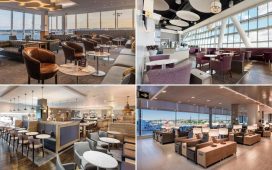‘And this also,” says Marlow, the narrator of Joseph Conrad’s Heart of Darkness, “has been one of the dark places of the Earth.” He’s talking about the stretch of the Thames estuary near Tilbury in Essex, that is now bookended by the imposing pylons of the cable-stayed Queen Elizabeth II Bridge and the bulk liquid storage facilities of Canvey Island. It’s a little downstream from Purfleet, which Dracula found a handy place to keep his 50 boxes of Transylvanian earth. It’s just off the A13 – a road, according to Iain Sinclair, of “memory, mess, corruption, dying industries, political scams, satellite shopping cities”.
So what better place to lift the spirits than this land where the villages are called Fobbing and Mucking, where your lockdown-weary lungs can inhale the scents of salty mud and – when you’re close to the Procter & Gamble factory in West Thurrock – soap? I can’t think of one. Why would I want to be anywhere else?
It’s partly a matter of natural beauty, the big skies above the expanses of marshes, the breadth of the river, the light. “The very mist on the Essex marsh,” Conrad also wrote, “was like a gauzy and radiant fabric, hung from the wooded rises inland, and draping the low shores in diaphanous folds.” There are such places as the Thurrock Thameside Nature Park, whose “skeins” of wildfowl are celebrated in Gillian Darley’s excellent book Excellent Essex.
There is history, too, for example the part-Saxon church of St Mary’s Corringham, with its stubby tower of arresting antiquity and its peaceful churchyard. There is Tilbury Fort, first built under Henry VIII, a half-millennium’s worth of low-slung bulwarks, of pentagons, moats and tunnels, of water and military geometry, progressively developed to withstand the guns and bombs of Spanish, Dutch, French and German enemies. Somewhere round here Elizabeth I made a famous speech.
But what makes this stretch of Essex special are its combinations of history and nature with big, blunt still-churning industry. If you’re bird-watching on the marshes, you might find your binoculars filled with huge stacked-up container ships, while the avian specks that you are seeking flit in front of them. Cranes and conveyors rise abruptly from the mudflats at the river’s edge, their powerful visual effect unintended, following as they do only their own practical logic. A sight during lockdown has been of moored cruise ships, biding their time until they might be used again, looming above the modest two-storey domestic architecture that is common round here.

The DP World London Gateway Port, just downstream from the nature reserve, is simply majestic. Wikipedia will tell you that it is “a fully integrated logistics facility, comprising a semi-automated, deep-sea container terminal on the same site as the UK’s largest land bank for development of warehousing, distribution facilities and ancillary logistics services”. Which I guess it is, but this description doesn’t do justice to the scale of its serried gantries, and the giant mechanical hands that can lift and distribute shipping containers as if they were sugar cubes. Conrad’s gauzy mist only makes them more sublime.
The poster child for the area’s fusions of industry and history is the church of St Clement’s in West Thurrock. It is handsome and flint-banded, your usual English exhibition of accretions over centuries, and of the slow evolution of techniques of laying stones and making windows. The shaggy-grassed graveyard, with tilting headstones and worn inscriptions, is also of a familiar kind. What makes it unique is the looming presence of the Procter & Gamble factory behind it, with its red and blue corrugated sheeting, its pipes and steaming flues.
This is where the marine air from the estuary mingles with the scents of products that will end up in your bathroom. It’s an outrage, you might say, a lamentable failure of planning, to treat a Grade I-listed building thus. But there’s room in this country for one mixed-use development like this, one such co-location of spiritual and bodily cleansing. And there are unexpected affinities of shape between the towers and striations of the factory and those of the church. You don’t have to take my word for it that St Clement’s is an exceptional place: the makers of Four Weddings and a Funeral validated it by choosing it as their most memorable location.
The English countryside, it is often said, is a working landscape, shaped by human as much as natural interventions. This truth is equally often forgotten, as the hedges and thatched roofs and coppiced woods that were once the products of urgent practical need get made into the stuff of biscuit tin lids. In estuarine Essex, where so many kinds of working are still going on, you can see the continuity between old bridges and watercourses and their modern equivalents. The ships and factories are not only magnificent, but they inoculate the wilder places around them from prettification.

This area feels unfinished as well as un-pretty, which gives it a sense of possibility. It has long been a place of new starts, of people looking for somewhere to do their own thing. At a large and organised scale this spirit includes the modernist factory and model town in East Tilbury, built by the Czech shoe company Bata in the 1930s, a remarkable vision of a hoped-for enlightened future. At a more individual level, the same spirit is manifest in gatherings of individualised static caravans, perhaps close to some roughly assembled stables. A horse here – and you see many – tends not to be a highly groomed pony club specimen, not a status symbol, but an opportunity for fun and freedom.
So, if this is your sort of thing, go, and enjoy the pubs and fish and chips and the salt beef bagels you can buy from catering vans. One place you shouldn’t visit is the site of Conrad’s former home in Stanford-le-Hope. It was replaced in the 1950s with an uptight brick house that is now fortified with a high, dark fence. The official commemorative plaque is dwarfed by an advertisement for a function room and carvery, which lie at the far end of a bleak car park. Whatever literary aura you might hope for has long departed. The horror, the horror, as Conrad might have put it.
Other follies and ruins to visit
Torfaen, Monmouthshire

Torfaen county includes Pontypool Park built in the 17th century during the area’s heyday. There’s 150 acres on which you can find Wales’s oldest dry ski slope, a stone circle, a shell grotto and a folly. Nearby is Blaenavon Industrial Landscape, declared a Unesco world heritage Site in 2000 for its record of the iron and coal industry. The area is also home to bogs, woods and nature reserves.

This nature reserve near Hull is home to wonderful wildlife and the ruins of an abandoned village (two more are under the waves nearby). There are also military defences, barracks and tunnels, some reaching back to Napoleonic times, as well as a renovated lighthouse.

Somehow it’s unsurprising that the model village is a British invention. This one in Torquay, opened in 1963 is exceptional, constantly updated to reflect contemporary life in miniature including scenes from EastEnders and a mini Shard.

The arts and crafts garden village built by the Cadbury family in the 1890s was created to house workers and those in need, to “alleviate the evils” of modern living conditions. Still a fascinating place to visit, not least because you can gorge on chocolate at the Cadbury’s factory visitors centre.

The ruins of the brutalist college for priests, completed in 1966, are listed as an endangered site. The seminary closed in 1980 and has fallen into disrepair through neglect, vandalism and fire. The Kilmahew Education Trust launched last year to help restore this Grade A listed building and the surrounding Kilmahew estate to its former glory.
Alice Fisher













